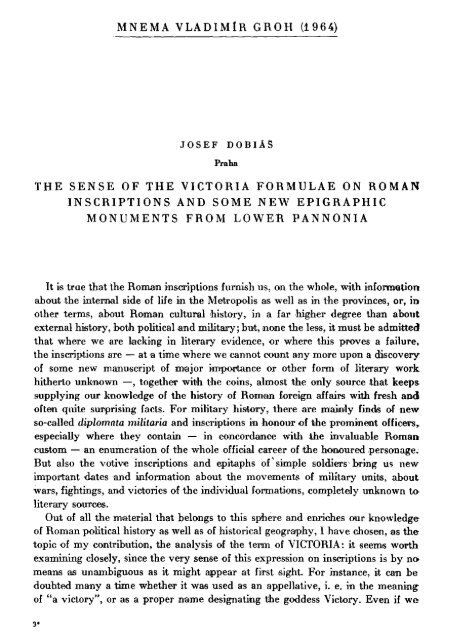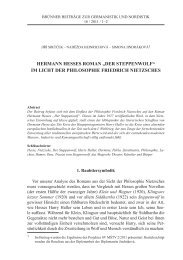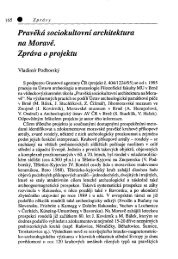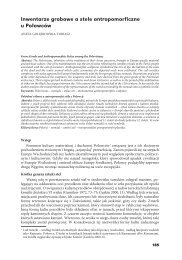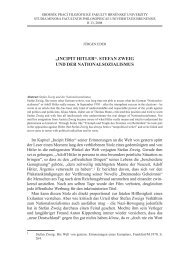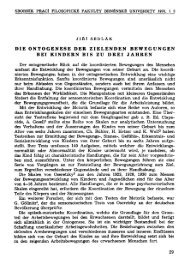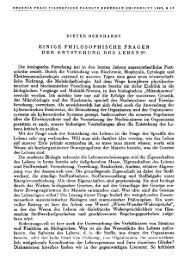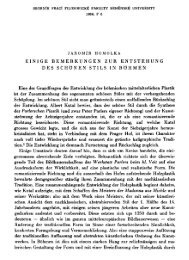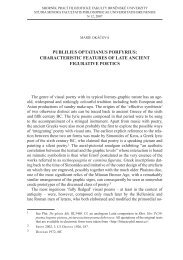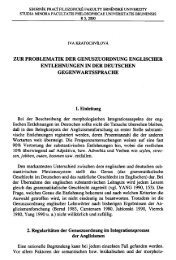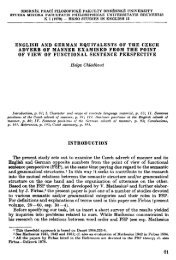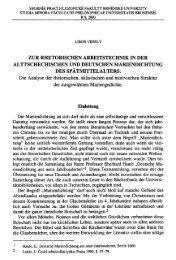M N E M A V L A D I M I R G R O H (1964 ...
M N E M A V L A D I M I R G R O H (1964 ...
M N E M A V L A D I M I R G R O H (1964 ...
You also want an ePaper? Increase the reach of your titles
YUMPU automatically turns print PDFs into web optimized ePapers that Google loves.
MNEMA VLADIMIR GROH (<strong>1964</strong>)JOSEFDOBlASPrahaTHE SENSE OF THE VICTORIA FORMULAE ON ROMANINSCRIPTIONS AND SOME NEW EPIGRAPHICMONUMENTS FROM LOWER PANNONIAIt is true that the Roman inscriptions furnish us, on the whole, with informationabout the internal side of life in the Metropolis as well as in the provinces, or, inother terms, about Roman cultural history, in a far higher degree than aboutexternal history, both political and military; but, none the less, it must be admittedthat where we are lacking in literary evidence, or where this proves a failure,the inscriptions are — at a time where we cannot count any more upon a discoveryof some new manuscript of major importance or other form of literary workhitherto unknown —, together with the coins, almost the only source that keepssupplying our knowledge of the history of Roman foreign affairs with fresh andoften quite surprising facts. For military history, there are mainly finds of newso-called diplomata militaria and inscriptions in honour of the prominent officers,,especially where they contain — in concordance with the invaluable Romancustom — an enumeration of the whole official career of the honoured personage.But also the votive inscriptions and epitaphs of simple soldiers bring us newimportant dates and information about the movements of military units, aboutwars, fightings, and victories of the individual formations, completely unknown to>literary sources.Out of all the material that belongs to this sphere and enriches our knowledgeof Roman political history as well as of historical geography, I have chosen, as thetopic of my contribution, the analysis of the term of VICTORIA: it seems worthexamining closely, since the very sense of this expression on inscriptions is by nomeansas unambiguous as it might appear at first sight. For instance, it can bedoubted many a time whether it was used as an appellative, i. e. in the meaningof "a victory", or as a proper name designating the goddess Victory. Even if we3'
38J. D O B I A Saccept the former alternative, we cannot consider it quite unquestionable. ThereforeI intend to examine all the formulae of the Roman inscriptions in which theterm of victoria appears, and to use then the results to a critical analysis of someof the latest epigraphic discoveries made on the soil of Lower Pannonia, whichare not without importance also for the history of its trans-Danuhian foreland,the actual Middle Slovakia.The simplest of these formulae is the plain nominative case, victoria — perhapsnever exemplified on inscriptions, in contrast to the coinage where it may beuniversally taken for the commemoration of a victory actually obtained, andparticularly in those cases where the word victoria is specified by a name of thenation or tribe over whom the day was carried. Out of very numerous evidence,some legends may be quoted, 1such as VICTORIA BRITANNICA on the coins ofCaracalla, VIC DAG'ca on those of Trajan, VICTORIA CARPICA on Philippus',VICT GER (or GERM or GERMA) on Marcus Aurelius' issues,VICT GOTHICA on the coins of the Emperor Claudius II — who became knownunder the name of Claudius Gothicuis just because of that victory —, VICTPARf/iica on the emissions of L. Verus, M. Aurelius, and Caracalla, some of whichfind their parallels on the triumphal issues bearing the legends DE GERMANIS,DA CIA CAPta, GERMANIA SVBACTA, etc.There is one circumstance which all of the quoted legends have in common:the expression victoria on coins is an appellative, not a proper name, and thusit signifies a victory, not the goddess, even if it is symbolised quite often — or,better, almost as a rule — by a figure of the goddess Victory on the reverse of therespective coin.But on the inscriptions, there is a real problem of two different possibilities tobe chosen between, which we meet with: a form fairly frequent on them is thedative case, VICTORIAE. Are we to hold this expression for a proper name,personal, and shall we transcribe it with capital letter, Victoriae, or is it a commonnoun, to be written victoriae? With regard to the exceedingly numerous analogieson inscriptions dedicated to various deities, the more probable is the possibilitythat by the VICTORIA here was meant the goddess 2 ; but even in those cases•where the word is completed by an attribute derived from the name of theEmperor or the vanquished people, both the name and the figure of the goddesscan be regarded as the symbol of an actual, concrete victory only where it canbe proved from other sources that the victory really took place. Such is the caseof the inscription on the rock of Trencin, in Slovakia, in which the dativeVICTORIAE AVGVSTORVm is to be interpreted definitely as "to the goddessVictory", but in the same time it may be taken in a metonymical sense, as "forthe victory awarded by the goddess Victory to both Emperors", Marcus Aureliusand his son Commodus. The raison d'etre of such an interpretation is given notonly by the report of Cassius Dio (LXXI 33; III. 273 ed. Boissevain) about the
THE SENSE OF THE VICTORIA FORMULAE39decisive victory obtained in the critical period over the people, in the very heartof whose dwellings the inscription was engraved, but also by the fact that thevictory of the two Augusti is proved by a new imperatorial acclamation theywere honoured with, and just in the same space of time the inscription must bedated to, i. e. A. D. 179. 3It goes without saying that the case of the Trencin inscription is quite unique.It is hardly conceivable that another inscription of an equal kind could be found,enabling us to determine the chronology of the incident recorded in it, as well asto insert it into the corresponding political situation with so great a precision.The next specimen, most approaching the precedent by its wording, VictoriaeCommod[i objhonorem [Ul]p. Maximus [et Ul]p. Avitus [II v(iri)] i(ure)d(icundo), iis an inscription from the Dacian Ampelum; but it is almost completelyenigmatic, because of lack of parallel records, both of epigraphic andliterary kind. Owing to its uncertain chronology, it cannot be decided whichpeople it was, the victory over whom was recorded here. Some historians, beingat a loss for any other conception, guessed at a victory gained over the Dacians,as suggested by a mention in the Biography of Commodus (SHA, Comm. 13, 5),vied Daci — of course not over the free, independent Dacians, but over somerebels among the inhabitants of the Province of Dacia: in Dacia imperium eiusrecusantibus provincialibus.Any nearer evidence is missing also for the victory of the Emperors SeptimiusSeverus and Garacalla, hinted at in the inscription from Brjgetio (CIL III 4364,11 082), 5 offered, on June 9, 207, by L. Egnatius Victor, the legate of UpperPannonia, to the Victory of the Emperors and the local garrison, the Legio IAdiutrix; therefore we have no chance, for the moment, to decide whether itconcerned a victory obtained perhaps some time in Africa (M. Platnauer, TheLife and Reign of the Emperor L. Septimius Severus. London 1918, 205, n. 4;Ritterling, Legio, in R.-E. XII. 2, 1925, 1398) or, more probably, the fightingson the Middle Danube (M. Besnier, L'Empire Romain de l'avenement des Severesau Concil de Nicee [Histoire Romaine IV. 1.] Paris 1937, 40 sq.; A. Alfoldi,Budapest tortenete. Budapest 1942, 670, n. 1; L. Barkoczi, Archaeologia HungaricaXXXVI, 1957, 517), or an entirely other occasion (J. Fitz, Der Besuch desSeptimius Severus in Pannonien im Jahre 202 u. Z. Acta Archaeologica AcademiaeSciemtiarum Hungaricae XI, 1959, 255), either to ascertain whether the dativeform victoriae may be regarded as expressing a prayer to the goddess of victory,or thanks for the fulfilment of such a prayer and for the granting of a definitemilitary success.With this problem we meet also in the victorious formulae which are the leastdisputable at first sight: the prepositional expressions pro victoria and obvictoriam. All doubts about the function of the term in question as an appellativeand not the proper name of the goddess are removed by the circumstance that
40J. D O B I A Sthese forms appear exclusively in the inscriptions dedicated to some other deitythan Victory as the giver of a victory. But there is a new problem here: whetherthe expression pro victoria is to be regarded as a votum susceptum, i. e. a wishand prayer for a victory, or a votum solutum, i. e. thanks for it. For politicalhistory concerned with facts, as well as for military history, naturally the lattercase alone comes into consideration. In solving this problem, the decisive factoris, I dare say, the general use of the terms votum and vota.The best known vota, because recurring regularly every year on the 3 rdofJanuary, were those for the welfare of the reigning Emperor, the vota nuneupata,suscepta pro incolumitate principis 6 . The same formula was used also in theexpression designating victory. Perhaps the most familiar and the most eloquentexample of it is furnished by the Acta fratrum Arvalium for the day of the 25 thMarch A. D. 101, on which day Trajan's Daciam War was embarked upon with thevota [pro salute et red(itu) et victor(ia)] (CIL VI2074, p. 530, line 51 sq.), thus wilha prayer for the Emperor's health and a happy and victorious return: the preciseGreek analogy and equivalent to the Latin preposition pro is vneo, meaningquite doubtlessly a request, not thanks for the victorious result. Thus, even if theformula pro victoria can sometimes express also thanks for an obtained victory,it is equally doubtless that it generally means a wish or prayer for a future victory,on inscriptions 63as well afc on coins 7 , and the more so since the inscriptions areusing longer sentences when expressing thanks in a solemn form: cf., for theEmperor Marcus Aurelius, a fragment of the inscription from his triumphal archat Rome (CIL VI 1014 = ILS 374), or, for Caracalla, an instance from the Actafratrum Arvalium of the year A. D. 214 (CIL VI 2103 b): quod salvus atqueincolumis — felicissime ad hiberna Nicomediae ingressus sit.On the other hand, only the formulae in which the term of victoria is connectedwith a causal preposition — most commonly with ob — can be applied withcertainty to a victory actually gained already; they are found in honoraryinscriptions of generals, recording the motives for their decorations. As examplesof this kind of inscriptions — not too numerous, on the whole 8— may be quotedthe honorary inscription to L. Vehilius Gratus, decorated ob victoriam belli Parthici,item [ob vicjtor(iam) belli Germ[a]nic(i) [et Sarmatic(i)] (ILS 1327), or a similarone, in honour of M. Bassaeus Rufus, the praefectus praelorio of the coemperorsMarcus Aurelius and Commodus, who was rewarded ob victoriamGermanicam et Sarmaticam which can, for other reasons, be dated with the utmostprobability to the year 177 9 .With the knowledge acquired from the above analysis of the varying sense ofthe epigraphic formulae containing the term of victoria, we can now proceed tothe evaluation of some older, but especially of some quite recently discoveredinscriptions, which are regarded as an indubitable testimony about the victorious,fighting of the Roman troops with the Dacians who are said to have invaded the
THE SENSE OF THE VICTORIA FORMULAE41northern part of Lower Pannonia from the actual Middle Slovakia, in tine earlyyears of the second decennium of the third century A. D. 10The inscriptions in question, all of which were found on the comparativelysmall area in the Vac hend of the Danube, limited in the north and east by thestream of the river, in the west by the original boundary between Upper andLower Pannonia, which had been shifted farther to the east in 214, and in thesouth extending up to Intercisa, are the following:(I) On the very frontier of the stated territory, in Nyergesujfalu, the ancientCrumerum, an inscription was discovered in 1960, dedicated to Deo invict[oJSerapi pro sal(ute) et victoria imp(eratoris) Caes(aris) M. Aurel. Antonini (G. Alfoldy,Studia Pannonica, 27).(II) From the area somewhat farther to the south comes an inscription known,formerly already, found in Csev, which was dedicated Iovi Optimo M[ax(imo)Neptuno and, besides, alsb Serap[idi] pro sal[ute et victor[ia et perpejtuitate ofthe same Emperor, by Alfenus Avitianus, probably the very first legatus propraetore of the newly organised province of Lower Pannonia (J. Fitz, L. AlfenusAvitianus). 11(III) Among the "victorious" inscriptions of this kind is counted by J. Fitz(Soggiorno 16) also the inscription from Aquincum (CIL III 3472 = ILS 2320),dedicated by the tribunus militjtm of the local Legio II Adiutrix, Clodius Marcellinus,dis militaribus et genio loci pro salute et reditu of the Emperor Caracalla,just because of the mention of the latter s return.(IV) Finally, there is an inscription from the south extremity of the territoryabove described (published by G. Erdely and F. Fiilep, Intercisa I. [ArchaeologiaHungarica XXXIII]. Budapest 1954, 323, No. 326), which must have been a partof a building, perhaps a temple (opus) dedicated by the soldiers of the CohortHemesenorum to their national god Elagabalus: deo patrio Soli Elagabalo prosalute et victoria Germ(anica) of the same Emperor Caracalla.(V) Among all these inscriptions mentioning expressly a victory, L. Barkoczi,Brigetio [Dissertationes Pannonicae II. 22]. Budapest 1951, 46, as well as J. Fitz,L. Alfenus Avitianus 9 sq., and Soggiorno 16 count also the monumentalcolumn from Tata bearing the inscription Imp. Caes. M. Aur. Antonin. (CIL III4274), erected in Caracalla's honour, only because also the figure of Victory isfound among the twelve deities represented on it (Sol, Luna, Apollo, Silvaous,Diana, Volcanus, Venus, Mars, Iuno, Victoria, Minerva). 12All these records, both strictly epigraphic and monumental, are regarded bytheir discoverers or commentators as proofs of a victory gained by Caracallabefore the 23 rdof August 214 — which is the date of the dedication of theEmesene soldiers on the inscription quoted above as No. IV: X Kal. Sept. Messalaet Sabino cos. — over the barbarians neighbouring with Lower Pannonia on itsnorthern frontier, therefore in the actual Slovakia. The formula pro victoria,
42J. DOBIAShowever, is no sufficient evidence for it, since it can signify, in accordance withthe mentioned analogous cases, a mere prayer just as well as thanks. In favour ofthe former possibility speak not only the recorded analogies, but, on theinscription No. II, also the last expression of the formula pro salute, victoria elperpetuitate 13which can have only the meaning of a wish, not of thanks, like onthe inscription No. Ill from Aquincum the combination of pro salute et reditu,where the term pro reditu corresponds completely with the votum known fromthe legend FORTVNAE REDVCI struck on the emissions of coins associated withthe departure of the Emperors for an expedition, in the sense of a prayer to theFate to bring back the Emperor safely after the obtained victory. 14It is therefore not possible to interpret the term of victoria on any of the•above quoted inscriptions with certainty as implying a definite victory. But stillmore dubious appear the explanations given hitherto of the nationality of the•enemies over whom Caracalla or his commanders were victorious.All the interpreters concerned have thought of the Dacians who, in theiropinion, had moved westwards as soon as the end of the second century; and,having taken their abode in the vicinity of Brigetio, threatened — together withthe Germans, amd especially with the Quadi — the neighbouring Lower Pannonia,•or even launched a pernicious attack upon it.The only circumstance supporting such a view was found by L. Barkoczi•(Dak tolmacs 178 sqq.) in an inscription discovered at Brigetio in 1943 whichmentions a Dacian interpreter, interprex Dacorum. Its dating is established witha comparatively considerable exactitude: the same person, Ulpius Celerinus, isnamed on another inscription from Brigetio, known before already (CIL III10988), in the function of a sal(ariarius) of the local Legio I Adiutrix which, onthis inscription, bears the cognomen of Antoniniana that it could have acquiredno sooner than the year 198 or, if it is derived from the name of the EmperorCaracalla, 211. 14aBarkoczi judged from just this inscription that the Dacians weresettled, in those days already, opposite to Brigetio, having got there under thepressure of the same Goths whose movement from the mouth of the Vistula in thedirection towards the Black Sea is regarded as the cause also of the pressure of thebarbarian tribes in the north from the whole stream of the Danube, whichmanifested itself in the so-called Marcomannic War.Such a conclusion is, of course, a little rash, since the presence of an interpreterfor the dealings with the Dacians in Brigetio is quite irrelevant for the nationalconditions in its trans-Danubian neighbourhood: Brigetio was one of the busiesttrade centres on the Middle Danube, 15which, in the milieu of a ,,half-BaIkan"jumble of all sorts of peoples by that time already, could by no means do withoutinterpreters, and especially for the Dacian language the expansion of which was soconsiderable in those days. 16The fact that a mention of a Dacian interpreter inBrigetio reached us is a mere chance, equally as the parallel record from Aquin-
THE SENSE OF THE VICTORIA FORMULAE43cum in which, besides a Sarmatian interpreter (CIL III 143495), also one for theGerman language is attested (CIL III 10505) — whom we should expect ratherin Brigetio, for the intercourse with the Quadi, but on whose mere existence inAqumcum hardly anyone would dare to build a theory on German settlementsin Alfold.There is, however, also some supposed epigraphic evidence in favour of theopinion that there were Dacians settling in the forefield of Brigetio towards theend of the second century A. D., on whom the Romans were then making wars —if they had not even to defend themselves from their attacks on their own ground.From Crumerum, situated at the very frontier of Lower Pannonia, far to thenorth, comes an epitaph (CIL III 3660 = ILS 2308) dedicated to Aur(elius)Satull(us), a soldier of the Legio I Adiutrix of Brigetio, who was killed in action(decidit), at the age of twenty-three, incursu hostis Daciae, and from Tatabanyathe tombstone of Aelius Iustinus, librariics legati of the same legion, aged twentyfive,who equally died (decid[it]) in exp(editione) Dacisca.But it seems to be rather bold to establish a temporal coincidence between thesetwo inscriptions — undated and, for the time being, undatable — and the preciseyear 214 A. D. In the first case, namely the inscription from Crumerum, it is justthe name of Dacia which proves an evidence against the supposed invasion of thefree Dacians into Pannonia, since on a Roman inscription, and even on a militaryone, it would be hardly possible to use the name of Dacia for anything else butthe Roman Province of Dacia: never could it mean settlements of any independent,free Dacians beyond the bounds of that province. It will be, therefore,necessary to think rather of an inroad of some (unnamed) enemy into Dacia,or — if the turn common in the names of towns be accepted here — to supposea closer connexion between the words hostis Daciae on one hand, and betweenDaciae decidit on the other hand, and thus to translate the context as „he diedin Dacia in the course of an enemy inroad". The Crumerum inscription would be,in any case, a part of some kind of cenotaph, similarly as the inscriptionof Tatabanya, and still another from Celeia (CIL III 5218 and 11601 == ILS 2309), dedicated to Aurelius Iustinus, a legionary of the Legio II Italica,obito iii exp(editione) Dacisca, or finally the one found in the surroundings ofVerona, reading Papirio Marcellino, decepto a Daciscis in bello proelio (CIL V3372 = ILS 8502), in which certainly no one would think of some hypotheticalDacians from the northern neighbourhood of Lower Pannonia.It is thus not possible to regard any of these conjectural testimonies aboutan expedition against the Dacians (expeditio Dacisca) or an inroad of theirs(incursu hostis Daciae) as applicable with certainty to the Dacians dwelling onthe left side of the Danube, and the less so to endeavour after a reconstructionof the directions of the supposed three invasions which are said to have all beendirected against Aquincum (see the plan No. 1 in G. Alfoldi, Studia Pannonica 30).
44J. D O B I A SIt appears a priori to be little probable that the graves of the killed soldiers weremarked by epitaphs directly on the 'battle-fields; and in the case of the tombstonefrom Crumerum, moreover, the same 'negative conclusion may be drawn from thevery absence on it of the formula h. s. e.But this is not enough: It is highly questionable even whether, during the firstyears of CaracaMa's reign, the Dacians did dwell at all in the region where theyare looked for on the basis of the above-mentioned inscriptions.Who was it to be meant in those inscriptions by the name of Dacians? First ofall, the possibility may be perhaps excluded that the Dacians in question were theinhabitants of the Province of Dacia: the'official terminology could hardly haveadmitted that it might have been necessary to wage a military expedition againstthe nations who were then integrant parts of the Roman Empire, and have thusindicated the existence of some rebellion, or — after all of the free inhabitants ofRoman provinces had been vested with the Roman civitas by the Constitution ofCaracalla — even the existence of a civil war. 17(We may but remember with whatdelicacy the leading circles in Rome, at the celebration of the triple triumph withwhich the last republican Civil War was closed in 30 B. C, evaded the embarrassingtruth that Octavianus was, as a matter of fact, celebrating his triumphover his own colleague-triumvir, Antony.) That is also why none of the interpretationsgiven hitherto of the above quoted inscriptions thinks of the Daciansof the Roman-province, but all of them hold for certain that it must be thoughtof those who were dwelling outside the boundary of the Province, or, in otherterms, of the free Dacians. There is no dou'bt that such Dacians did exist still inthe second and third centuries, in spite of the express assertion of an inscriptionfrom Corinth, dedicated to C. Caeliuis Martialis, a participant in the SecondDacian War of Trajan, in 107—113, qua universa Dacia devicta est. 16Those free Dacians who did not belong to the bounds of the province are mentionedin the period preceding by some thirty years Caracalla's succession to thethrone: it was in the time of the general attack of all the northern neighbourson the Empire, which is usually designated by the inaccurate term of MarcomannicWars. The legate of Dacia, (C. Vettius) Sabinianus (Iulius Hospes) 19intended to satisfy — at least partly and for the moment — the avidity of thosefree Dacians for soil, which kept manifesting itself in their incessant inroads intothe territory of the Province, by promising them lie would settle 12,000 Aaxatvratv nQoaogcov on the grounds of the province, evrfj Aaxta xfj fme.Ti.Qq.(CassiusDio LXXI1 3, 3; III 284, ed. U. Boissevain). Commodus, assuming the rule,wanted to make the other Dacians respect the boundary of the Province, by oneof the terms of his treaty of peace dictated to them in A. D. 180, in which theybound themselves under oath that they would let unsettled and uncultivateda zone of their territory bordering on the Roman province in a width of 40 stadia,i. e. nearly 8 Jim.: avayxdaac, rovg &XXovg dfioaai mare \if\T evoixrjoeiv TIOTB
THE SENSE OF THE VICTORIA FORMULAE45firyt iwefielv TeoaagaKovTa arddia rfjg x^Q A ? o~v rfjg TIQOQ rfj Aaxia ovorjg.If we wish to form an estimate of the area occupied by those free Dacians,it would be necessary to ascertain, in addition to its eastern boundary which wasfixed by the frontier of the Province of Dacia, 20also its western border. Thewritten sources are, unfortunately, very scarce indeed. The most ancient is Caesar'sBellum Gallioum (VI 25, 2), giving a description of the situation of the HercynianForest which is said here to extend from the head of the Danube, running at firstparallel with this river up to the territory of the Dacians and the Anartii, where itturns aside from the Danube to the left (i. e. to the north): Hercynia silva, oriturab Helvetiorum et Nemetum et Rauricorum finibus rectaque fluminis Danubiiregione pertinet ad fines Dacorum et Anarliorum. Hinc se flectit sinistrorsusdiversis a flumine regionibus. It is questionable which place is meant by Caesarin this „lurning aside" from the Danube. Brandis, Dacia, in R.-E. IV. 2, 1901,1952, thought of the bow of the mountains of Matra, Bilkk, and Hegyalja, protrudingto the north-east from the Vac bend of the Danube. But since thesettlements of the Dacians in Augustus' days reached westward up to the Moravariver (Marus-March), 21and because Caesar's words, in a strict interpretation, donot imply anything more than that the Hercynian Forest diverged from the streamof the Danube which — it is to be presumed — was keeping its original direction(recta regione), and as in the first century B. C. all the sharp changes of directionof the Danube were not yet known, 22we shall perhaps have to identify the mentionedpart of the Hercynian Forest, diverging from the river, rather with theLesser Carpathians where the deviation of the mountain chain from the streamof the Danube is most striking, even for an observer of to-day who would arrive,like Caesar, from the west, and proceed eastwards. For the whole large plain ofSouthern Slovakia separates in this region the mountains of the Hercynian Forestfrom the Danube, up to their next mutual approach behind the Hron river. AlsoF. G. De Pachtere 23 and lately A. Alfoldi 24 interpret the quoted passage of Caesaras referring to the Lesser Carpathians.In conformity with Caesar's notion of the extent of the area inhabited by theDacians is Strabo's information (VII 3. 1, p. 295) saying that the territory ofSouthern Germany, occupied by the Hercynian Forest settled by the Suebi,bonders directly on the Geti, i. e. the Dacians. 25This is, of course, a statementvalid only at a time when the Sarmatian Iazyges, who had repelled the Daciansfrom the Morava river eastwards, up to the region behind the Tisa, had not yetinvaded the Great Hungarian Plain. Till then, the Dacian settlements had reachedwestward up to the Morava river, but, according to a report of Pliny the Older(Nat. Hist. IV 12, 80), they were pushed back, behind the Tisa, by the invasionof the Iazyges some time between the year 15 A. D. and the beginning of thetwenties. 20Towards the end of the first century A. D., an account by Tacitus (Germ. 1)
46]. DO BIASadds new information to the estimate of the extent of the Dacian region: Tacitusaffirms that the boundary between the Germans and the Dacians is formed bymountains: Germania omnis a Sarmatis Dacisque mutuo metu out mondbusseparator. By these he is sure to have meant the mountain chain that still Ptolemy(II. 11, 4 sq.: III. 5, 1; 7, 1; VIII. 10, 2) called „the Sarmatiam mountains(ZaQfiaTixa OQTJ) and which it is possible to identify, with certainty, with tJmountains extending in a large curve from the Vac bend of the Danube to thenorth-east, and join, in the Tatra, the enormous bow of the Carpathians, theancient Bastamian Alps. It is only to be expected, a priori, that this bow or line,forming the water-shed between the tributary rivers of the Danube and those ofthe Tisa, was also a dividing line of nationalities. This supposition is confirmed bythe subscription of the I stbook of the Soliloquies of the Emperor Marcus, by hisstatement that the book had been written on the river Hron, in the region of theQuadi: iv Kovddotg ngog ra> rgavovq. The German Quadi were thus settled inthe seventies of the second century A. D. — that is to say, some forty years beforethe reign of CaraoalJa — on the Hron river, their homes reaching, of course, atleast as far as the river Ipel' (1/poly) which flows into the Danube in a directionparallel, on .the whole, with the Hron, merely about 9 km. farther to the east. 263And since it'was, with the utmost probability, just the valley of the Ipel' wheremay be laid the dwellings of the Osi, 27attested, if not already by the ElogiumTusculamim 28before the beginning of our era, so at the latest from the end of thefirst century A. D., up to the Marcomannic Wars, 29since, furthermore, the settlementsof the Celtic Cotini may be localised on the Upper Hron, and those of theSuebian Buri — neighbouring, in the west, directly upon the Quadi (Cassius DioLXXI 18 and LXXII 2, 4) and, in the east, upon the Dacias (ibid. LXVIII 8, 1)— with the utmost probability in the valley of the Upper Vah, and since, consequently,there was indeed no room left in the actual Middle Slovakia for theDacians, 293we are returning back to the statement of Ptolemy that the northwesternboundary of the Dacians were the Sarmatian Mountains. This fact aloneseems to me to exclude any possibility that the free Dacians could have invadedLower Pannonia from the valleys of the rivers Hrom and Ipel' at the beginningof the third century. Why should they have taken the trouble over such a longdetour; in order to get, by an outflanking manoeuvre, to Aquincum, when theyhad a far shorter and easier route across Alfold? In both cases they had to crossthe Danube in the sectors equally well protected not only by the two mightymilitary camps, Brigetio and Aquincum, but also by a series of minor fortresses(burgi) built by the Emperor Commodus in order to strengthen the Pannonianlimes in that region. 30The fact that there were the Sannati dwelling in Alfold could hardly imply anyserious obstacle, as this steppe-people lived in a state of perpetual hostility to theRomans, and even if they had not taken an active part themselves in a predatory
THE SENSE OF THE VICTORIA FORMULAE47incursion, they hardly could be expected to prevent others from waging it..Of course, an objection could be raised that the national conditions in thatregion might have changed during those thirty eyars which had elapsed from theMarcomannic Wars to the period of Caracalla's reign. For instance, there are justthe Osi who can be supposed to have been emigrated from their ancient settlementsbehind the Danube into Pannonia, 31so that their ancestral homes couldhave been then dccupied by the Dacians. But there is a fact again which contradictssuch a conjecture: The whole of the area from Brigetio eastwards up to thenatural boundary of mountains was occupied, at least to the end of the secondthird of the fourth century, as well as it had been at the second, by the GermanQuadi — as follows from the accounts of Ammianus Marcellinus about the militarycampaigns of the Emperors Constantius II (337—361) and Valentinianus (364—375) against the said tribe. In the reign of the former, the Roman armies advancedtowards Brigetio, in order to suppress also there the last remnants of the waragainst the Quadi who were inhabiting those places, 32and when Valentinianusreached Brigetio in 375, the Quadi submitted themselves to him, viso exercitwin gremio regni solique genitalis. It follows also from the narration of the sameauthor that the Quadi of the surroundings of Brigetio were then occupying theregion still farther to the east — as far as the Sarmatian Mountains: Ammianus-Marcellinus describes how the Emperor advanced from Alfold to Aquincum, andhaving built there a pontoon-bridge for all events, he crossed then the, river inanother place and proceeded against the Quadi who took refuge, in theirperplexity and uncertainty, to the impassable mountains, apparently the NogradMountains, where they lay in wait for his arrival. 33Under these circumstances it is very difficult to imagine that the Dacians wouldhave got thus far, from such a distance as the borders of the Province of Dacia,and that they could, from the territory on the opposite side of the Danube(i. e. from the area between the actual Komarno and Esztergom), launch anattack upon the domain of the Empire, some time in the years 212—214, andfinally that Brigetio, together with its surroundings, might be then annexed toLower Pannonia from fear of them.Just as dubious as the existence itself of any free Dacians in the above-saidterritory is also the dating of the conjectural fightings of the Romans with them.The invasion was dated to the second half of the year 212, but definitely beforethe end of that year, for the only reason that with the supposed suppression of itwas connected the conferment on three legions of Upper Pannonia of the honorarycognomen of Antoniniana, appearing on the inscription from Carnuntum already(CIL III 4452 and 11093 = ILS 2382 = E. Varbeck, Milkariraschriften aus.Carnuntum [Rom. Forschungen in Niederosterreich 2], 1954, No. 241) whichcan be dated with precision between the 10 thand the 21" of December 212. Butthe supposition that the honorary cognomina derived from the names of the
48J. DOBlASEmperors were conferred on the military units exclusively as a distinction fortheir war succes is far from being provable: 34they could be received just as wellon the occasion of the Emperor's visit 3 5as a manifestation of loyalty of the legionaries,similarly as it was the case of the same cognomina which were acceptedby the municipalities in order to show their loyalty when the ruling Emperorwas visiting them on one of his journeys round his provinces. Even the formulaelike the one on the above quoted inscription of the special military ranks of thethree legions Antoniniarum of Upper Pannonia, devotissimi numini eius (i. e. theEmperor's), or numini eius 'semper devotissimus on the Aquincum inscription ofthe tribune Clodius Marcellinus who was transferred from the Legio X FretensisAntoniniana to the Legio II Adiutrix Antoniniana (CIL III 3472), commend suchexplanation.It is therefore not possible to regard the fightings of the Romans with the freeDacians in the years 212—214, or an invasion of the latter into Lower Pannonia,as satisfactorily proved, and the less so in a period when the line of the limes inthis sector became almost insurmountable because, the boundary between the twoPannoniae having been moved on eastwards as far as beyond the junction of theVah (Waag) with the Danube, the defensibility of the limesi fortifications wassubstantially heightened owing to the annexation to Lower Pannonia of the wholemilitary zone of the camp of Brigetio, i. e. of the entire Legio I Adiutrix, as wellas of some auxiliary units garrisoned at ALmasfiizito, at Crumerum (the actualNyergesujf alu), and at Salva (Esztergom). Even the presence of the Emperor canbe guessed at for that period, on the south shore of the Danube, when he waspassing through that region on the occasion of his oriental expedition. 36Against the above stated facts, it is possible to argue only that these couldhave been just the reasons why the invasion failed and the Dacians were defeated— an argument which seems to be supported by the mentions of a victory oninscriptions, especially on the one from Nyergesujfalu. But it has been demonstrated— and this was the original aim of the present contribution — that theformula pro victoria which occurs on both of the inscriptions in question, doesnot signify, as a rule, a victory actually gained, but merely a votum susceptum,a prayer for it.The case of the inscriptions with the formula pro salute, reditu el victoria,which were dedicated to Septimius Severus, almost as a mass phenomenon, inPannonia in the year 202, is by no means comparable with that of Caracalla's:Septimius Severus was, in 202, on his way back to Rome after the victoriousconclusion of his eastern campaign, whereas Caracalla was, in 214, marchingthrough the same country when undertaking an expedition against the Parthians,the victorious result of which could be then only wished for in advance.Translated by Hana Kvicalovd
THE SENSE OF THE VICTORIA FORMULAE49NOTES1A more exhaustive enumeration is given by S. W. Stevenson — C. R. Smith —— F. W. Madden, Dictionary of Roman Coins. London 1889, 860 sqq.; Mas Bernhart,Handbuch zur Munzkunde der romischen Kaiserzeit. Textband. Halle (Saale) 1926, 245 sqq.2L a 11 e, Victoria, in W. R. R o s c h e r, Ausfiihrliches Lexikon der griech. u. rom.Mythologie VI, 1924-1937, 294 sqq.3J. D o b i & §, Novy napis ze Zany (Diana Veteranorum) a ffmsky napis na skale trencinske.(A New Inscription from Zana and the Roman Inscription on the Rock of Trencin.)Listy filologicke LXXX, N. S. V, 1957, 179—196; the same author, La seconda spedizionegermanica (see note 9j 9 sqq.4CIL III 7842. Cf. J. M. H e e r, Der liistorische Wert der Vita Commodi in der Sammlungder Scriptores historiae Augustae. Philologus. Supplemenlband IX, 1904, 175; transcription byDomaszewski.5In both of the instances Gyor (the ancient Arrabona) as the finding place of thisinscription is indicated; but in fact it was found at Brigetio (Ritterling, Legio, in R,—E.XII. 1, 1924, 1325, and XII. 2, 1925, 1398 f.; L. Bark6czi, Brigetio [Dissert, pannonicaeII. 22]. Budapest 1951, 62, No 241).6G. H e n z e n, Acta fratrum Arvalium quae supersunt. Berolini 1874, 89 sqq.. — On votaextraordinaria, see ibid., 114 sqq.6 aA most convincing proof is furnished by the inscription of Oslia, dedicated pro salute etreditu imp. Antonini Aug., Faustinae Aug. liberorumque eorum etc. (CIL XIV 20 = ILS 372)because in this, instance, the mentiomed Empress Faustina never returned home from theEmperor's expedition against the usurker Avidius Cassius, on which she had accompanied herhusband together with the whole family: she died at the Cappadocian Halala.'Paul L. Strack, Untersuchungen zur romischen Reichspragung des zweiten JahrhundertsI. Stuttgart 1931, 215 sqq. with note 930.8Enumerated by Paul S t e i n e r, Die dona militaria. Bonner Jahrbttcher 114/115, 1906,47 sqq. Cf. B. B a r b i e r i, Nuove iscrizioni di Marsala. KQ KAAOE' tstudi pubblicati dall'Istitutodi Storia Antica dell'Universita di Palermo VII, 1961, 16 ff.9CIL VI 1959 = ILS 1326. Cf. J. Dobias, Expeditio Germanica secunda et tertia.„Ceskou minulosti". (Volume of papers dedicated to Prof. V. Novotny in occasion of his 60 t!lbirthday.) Praha 1929, 16 sq.; the same author, La seconda spedizione germanica degli imperatoriMarco e Commodo alia luce delle iscrizioni. Atti del terzo Congresso internazionale diepigrafia greca e latina (Roma 4—8 Settembre 1957). Roma 1959, 6 sq.10Bibliography; L. Barkoczi, Dak tolmacz Brigetioban — Ein dakischer Dolmetscherin Brigetio. Archaeologiai ertesito. Ser. Ill, V-VI, 1944-1945, 178-192; G. A1 f 6 1 d y, StudiaPannonica 2. Serapis oltar Nyergesujfalubol — Ein Serapis-Altar a us Nyergesujfalu. Ibid. 1961,26—31; J. Fitz, L. Alfenus Avitianus [Istvan kiraly muzeum kozlemenyci. A. TanulmanyokFejer megye multjabol 10]. Szekesfehervar 1960; The same author, II Soggiorno di Caracallain Pannonia nel 214 [Accademia d'Ungheria in Roma. Quaderni di documentazione II. 2, 1961];The same, A Military History of Pannonia from the Marcomann Wars to the Death of AlexanderSeverus (180—235). Acta Archaeologica Academiae Scientiarum Hungaricae XIV, 1962, 25—112.11CIL III 3637. Emendated reading in: L. Bark6czi, Az V-S beltik sajalos osszekotesim6dja a pannoniai feliratokon — Eine spezielle Ligatur der V-S-Buchstaben auf pannonischenInschriften. Archaeol. ertesito 1941, 26, No. 6. An almost complete counterpart to the quotedformula is furnished by the inscription of Porto, dedicated tinio aanrjQlaQ xai inavodov xaiaidiov Suifiovfjt; of the Emperors Seplimius Severus, Caracalla and Iulia Domna (IGRRP I380). On Alfenus, besides Fitz's quoted paper, cf. also his new paper LegaLi Augusti pro4 62-77
50J. DOBlASpraetore Pannoniae Inferioris. Acta anliqua Academiae scientiarum Hungaricae XI, 1963, 287 f.15Arnold Scliober, Der Gotterpfeiler von Totis. Belvedere VI, 1924, 177 sqq. (notavailable here); L. Barkoczi, Brigetio [Dissertationes Pannonicae II, No, 22]. Budapest1944, Taf. LVIII, 1-3. Cf. W e i n r e i c h, Zwolfgotter, in W. R. Roscher, Ausfuhr. Lexikoi.der griech. und rom. Mythologie VI. 809 sqq.; C h. P i c a r d, L'autel circulaire du Dodekatheond'Oslie et le culte des douze dieux dans l'Empire romain. Revue des etudes latines XXIII, 1945,44—47; Erwan Marec, Un lemoignage du culle des douze grands dieux a Hippone.Libyca VII, 1959, 121-140.13Unless the word perpetuitas might have been used in a lowered sense, as an equivalantto the expression incolumitas, just like in the thanksgiving formula in the Acta fratrumArvalium quoted above (p. 40).MThe legend FORT RED or, in full, FORT REDVCI, is not to be taken always fora thanksgiving form for a return, as e. g. in the well-known example of Augustus who, on thereturn from the Orient in 19 B. C, accepted, out of all the honours offered to him, only the oneof consecrating of an altar to the goddess Fortuna Redux ( Tvxfl'Enavayebyw) by the Senate(V. Gardthausen, Augustus und seine Zeit II. 2, 483 sq., n. 187): this follows mostconvincingly from the fact that when some Emperors were leaving for a military expeditionabroad, coins bearing the legend PROFECTIO AVG as well as those with FORT RED werestruck quite simultaneously, although it is out of the question (also from otherreasons) that the Emperor could have returned from his expedition in the meantime(C. H. D od d, Chronology of the Eastern Campaigns of the Emperor Lucius Verus. NumismaticChronicle 1911, 213 and Chronology of the Danubian Wars of the Emperor Marcus Antoninus.Ibid. 1913, 172 sq.; Paul L. Strack, Untersuchungen zur rom. ReichsprSgung des zweitenJahrhunderts 1. Stuttgart 1931, 215 sqq. with n. 930). Therefore, also the simultaneously issuedcoins with the legend SALVTI AVG may be interpreted only as a wish for the health for thecoming expedition, not as thanks for the Emperor's happy and safe return.i 4 aThe cognomen Antoniniana is applicable not exclusively to Caracalla, though in themajority of cases, it is he who would be meant by it -, since it is met with as early as underSeptirriius Severus. The term of 201, given by G. M. Bersanetti, I soprannomi imperialivariabili degli auxilia dell' esercito romano. Athenaeum XXVIII, N. S. XVIII, 1940, 110 ff.was pushed back to the year 198, if not even to 196, by J. F i t z, Der Besuch des SeptimiusSeverus in Pannonien im Jahre 202 u. Z. Acta archaeologica Academiae scientiarum HungaricaeXI,1959, 254.15Cf. an inscription therefrom, CIL HI 4288, dedicated gem'o commerci et negotiantiumof the place, in addition to other material evidence about the local trade in which also Orientalmerchants, and especially the Syrians, played an important part: J. D o b i a s, Orientalnivlivy v fimskem Podunaji — Oriental Influences in the Roman Danubian Basin. Volumededicated to Prof. J. Bidlo in occasion of his 60 thbirthday. Praha ^928, 27 sqq.; the sameauthor, Le strade romane nel territorio cecoslovacco [Istituto di studi romani. Quadernidell'Impero Le grandi strade del mondo romano V]. Roma 1937, 8 sq. with n. 13—15;L. Barkoczi, Brigetio 20 sq.18Carl Patsch, Beitrage zur Volkerkunde von Sudosteuropa V. 2. Der Kampf um denDonauraum unter Domitian und Trajan. Sitzungsberichte der Akademie der Wissenschaften inWien. Philos.-hist. Kl. 217, 1, 1937, 181 sq.17A different matter are the accounts of chronicles or annals, as well as those of biographies(see above, p. 39).mOscar Broneer, Excavations in the Agora at Corinth. American lournal of ArchaeologyXXXVII, 1933, 567 sq. = L'Annee epigraphique 1934, No. 2. R - G. Pflaum, Lescarrieres procuratoriennes equeslres sous le Haul-Empire romain I. Paris 1960, 170, N. 74.
THE SENSE OF THE VICTORIA FORMULAE5119A. Bet z, Vettius 43), in R.-E. VIII A 2, 1958, 1866.2 0M. M a c r e a, Apararea grnnitei de vest si nord-est a Daciei pe timpul imparatuluiCaracalla. Studi si cercetari de istorie veche VIII, 1957, 215—251.2 1Strabo VII 1. 3. p. 290: rd ye rwv Eorjflmv e&vt] ra /iiv ivzdg oixel, rd Si ixzoqrov {'EQXWIOV] dovfiov, dfioga TOIQ riratg; Pliny the Older, Nat. Hist. IV 12, 80 (see n. 26).2 2K. M tiller, Die Sltesten Weltkarten VI. Stuttgart 1898; E. Polaschek, Ptolemy'sGeography in a new light. Imago mundi XIV, 1959, 32 sq.2 3F. G. De Pachtere, Salluste et la decouverte du Danuhe. Ecole francaise de Rome.Melanges d'archeologie et d'histoire XXVIII, 1908, 82 sqq.2 4A. Alfoldi, Zur Geschichte des Karpatenbeckens im I. Jahrhundert v. Chr. [OstmitteleuropaischeBibliothek 37]. Budapest-Leipzig 1942, 10 and 24.25To de voxiov /Mgog rrJQ TeQ/iaviaQ rd [ih> owe%et; dx/j,ijv vno zwv Eor\P
52J. D O B I A Sments is — in spite of their conventional designation — completely enigmatical, and their chronologyis equally uncertain and hardly compatible with the period about 200 A. D.: allattempts made up to the present at their dating have attributed them to a far earlier period.3 0J. D obi a 5, Expeditio Germanica Secunda et Tertia, 29 sq.; J. Fitz, A militaryhistory of Pannonia 76 sq.31J. D o b i a 5, Epigrafickd studie k dejinam a n&rodopisu ceskoslovenskeho uzemf 3. Osi.Casopis Narod. Musea XCVII. 1, 1923, 220 sq.3 2Ammianus Marcellinus, XVII 12, 21: His in barbarico geslis Bregetionemcastra commota sunt, ut etiam ibi belli Quadorum reliquiae, circa illos agitantium tractus,lacrimae vel sanguis extinguerent.9 3Ammianui Marcellinus, XXX. 5. 13: Praemisso Igitur Merobaude - - - advastandos cremandosque barbaricos pagos —Valentinianus Acincum propere castra commovnavigiisque ad repentinum casum coniunctis et contabulato celeri studio ponte per partaliarn transiit in Quados, speculantes quidem ex diruptis montibus cius adventum, quo plerancipites incertique accidentium cum suis caritalibus secesserunt, sed stupore defixos, cumregionibus suis contra quam opinabantur augusta cernerent signa.34R itterling, Legio, in R.-E. XII. 1, 1924, 1324 sq. and XII. 2, 1925, 1367 sqq.;G. M. B e r s a n e 11 i, I soprannomi imperials variabili degli auxilia dell'esercito romano. AthenaeumXXVIII, N. S. XVIII, 1940, 107 sqq.; J. Fitz, Besuch des Septimius in Pannonien(see n. 14a) 254 sq.3 5So J. D o b i a I, K datovani fimskych cihel ze Stareho M£sta na M^rave (The Datingof Roman Bricks from Stare Mesto in Moravia). Archeologicke rozhled^ XIV, 1962, 60, n. 10.3 6This objection to the explanation of G. AH old y, Stadia Pannonica 31, was raised byJ. Fitz, II soggiorno di Caracalla, 14, n. 78. Fitz himself is connecting the hints of theinscriptions at a Dacian war rather with the account in Cassius Dio LXXVTII. 27. 5. III.435 ed. Boissevain, that Caracalla came to an agreement with the Dacians and received hostagesfrom them.


